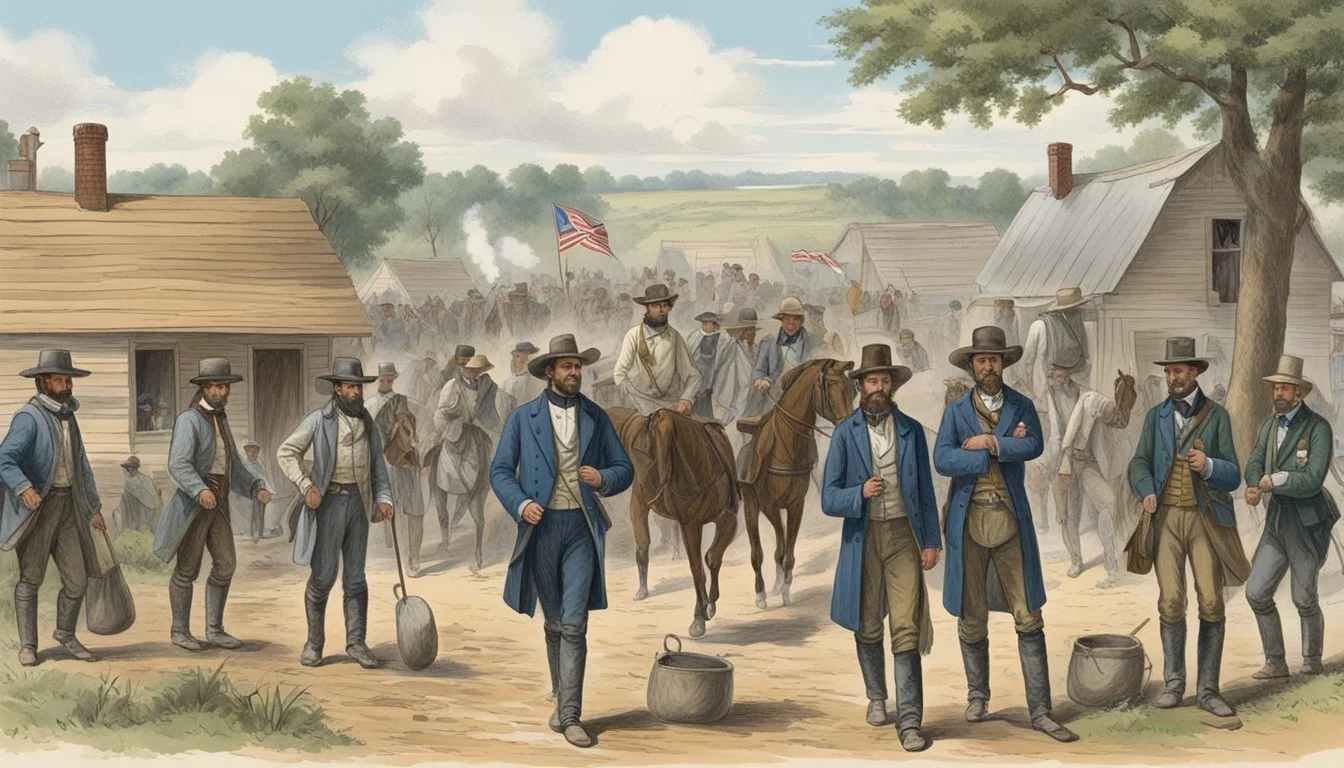The Role of German Texans in the Civil War
Impact and Allegiances
The role of German Texans during the Civil War is a subject of significance in the annals of American history. The complex interplay of cultural identity, political allegiance, and social values shaped the experiences of this substantial ethnic group in one of the nation's most tumultuous periods. German Texans, a diverse community with varying views on slavery and states' rights, found themselves in a precarious position as the question of secession divided the United States.
In Texas, which seceded from the Union and joined the Confederate States of America, the German population exhibited mixed reactions. Many German immigrants, particularly those who had fled political strife in Europe, were inclined to support the Union due to an opposition to slavery and an adherence to ideals of liberty and democracy. Nonetheless, there were also German Texans who aligned with the Confederacy, influenced by their ties to the local community and economic interests.
Consequently, German Texans served on both sides of the Civil War, with thousands taking up arms for the Union and others for the Confederacy. Their participation and attitudes reveal the complexities of ethnic allegiance amidst national conflict and highlight how local dynamics influenced broader historical trajectories within the United States during the Civil War.
Historical Context of German Immigration to Texas
The German immigration to Texas in the 19th century established a significant cultural footprint, with patterns, settlements, and contributions that shaped the region's demographic.
Origins and Immigration Patterns
German immigration to Texas began in earnest in the 1830s. Economic opportunity and the promise of religious freedom drew the first waves of German immigrants. The pivotal year of 1845 saw the annexation of Texas to the United States, aligning with an influx of Germans seeking a new life away from the political turmoil of Germany. Among these were the 'Forty-Eighters', political refugees who fled the failed 1848 revolution. By 1847, the German Emigration Company had facilitated the arrival of over 7,000 German immigrants to Texas.
Year: 1845
Key Players: German Emigration Company, Forty-Eighters
Main Pull Factors: Economic opportunities, religious freedom
Settlement and Social Structure
Upon arrival, many German settlers headed to Central Texas and the Texas Hill Country. Here, they established tight-knit rural communities, which over time, developed a social structure embedded with their native customs and agricultural practices. Settlements in East Texas were less common, with most German immigrants favoring the central region. The German population in Texas grew steadily, with families establishing homesteads that set the groundwork for future German-community centers.
Preferred Regions: Central Texas, Texas Hill Country
Settlement Characteristics:
Tight-knit communities
Customary German practices
German Communities and Cultural Impact
The German community in Texas wielded considerable influence on local culture, language, and traditions. They founded schools, churches, and social organizations, ensuring the continuation of their cultural identity. The German Texans' culture was marked by its architecture, music, and festivities, which have since become integral to the state's diverse heritage. Key cultural aspects like Oktoberfest are directly attributable to Texas's German population, illustrating the lasting impact of the immigrant community.
Cultural Contributions:
Architecture: Utilitarian and recognizable German-style buildings
Music: Introduction of polka and waltz
Festivities: Annual celebrations such as Oktoberfest
Throughout, the German Texans maintained a distinctive presence, contributing to Texas's demographic and cultural landscape even through the era of the Civil War.
Texas in the Antebellum Era
Before the Civil War, Texas underwent significant changes in political alignment, socioeconomic structure, and attitudes towards slavery, which played a crucial role in defining the state's position during the period.
Annexation and Statehood
In 1845, Texas was annexed by the United States and joined the Union as the 28th state. Initially, its annexation was a contentious issue, given Texas' history with Mexico and the implications for the balance of power between slave and free states. The capital, Austin, became the epicenter of political discourse as institutions of slavery became more entrenched in Texas society in the following years.
Socioeconomic Factors and Slavery
The economy of Texas in the Antebellum period was heavily reliant on agriculture, with cotton being a major crop. This reliance fostered the growth of institutions of slavery as plantation owners sought to maximize their profits. By 1860, the number of slaves had grown exponentially, signifying Texas' integration into the socioeconomic fabric of the South.
Political Climate and Secession
The political climate in Texas changed markedly following the secession of South Carolina from the Union in December 1860. Debates in Austin and across Texas intensified, and on February 1, 1861, Texas officially seceded from the Union to join the Confederacy. This political shift was influenced by the state's commitment to the institutions of slavery and aligned it with other Confederate states in the Civil War that followed.
German Texans and the Civil War
German Texans played a complex role in the Civil War, marked by notable service in the Union Army, internal strife due to conflict of ideals, and a tragic confrontation known as the Nueces Massacre.
Military Participation and Opposition
German Texans were a distinctive group within Texas, a state that had seceded to join the Confederacy. They enlisted in both the Union and Confederate armies, yet the majority harbored abolitionist sentiments and opposed the Confederate cause. The group's steadfast commitment to their principles often resulted in tension within the largely Confederate state. Many German Texans faced societal and political repercussions due to their Unionist and anti-slavery stances, which sometimes escalated to violence and persecution.
Internal Conflict and the Nueces Massacre
The internal conflict among German Texans culminated in the Nueces Massacre, which occurred near the Nueces River on August 10, 1862. This brutal event resulted from heightened animosity between secessionist Anglo-Texans and German Texans who largely supported anti-slavery and pro-Union causes. Martial law and conscription laws enforced by the Confederacy exacerbated tensions, leading a group of German Texans to attempt fleeing Texas in the hopes of joining the Union Army. Tragically, Confederate soldiers intercepted them, leading to the deaths of many Germans, a dark chapter in the history of German Texans during the Civil War.
Contribution to the Union Effort
Despite the animosity they faced, German Texans made significant contributions to the Union effort. With a sizable number of the population serving in the Union Army, their military engagement provided valuable support against the Confederacy. Their participation was driven by a staunch opposition to slavery and a commitment to the principles of unionism, making German Texans an integral part of the Union's diverse fighting force during the Civil War.
Key Figures and Leadership
The role of German Texans in the Civil War was shaped significantly by a number of key figures and leaders. Their contributions ranged from strong political stances to active military participation on both sides of the conflict.
Prominent German Texans in the War
Edmund J. Davis and Andrew J. Hamilton were prominent political leaders with Unionist sympathies. Davis served as a judge and Unionist leader before becoming a brigadier general in the Union army. Post-war, he was elected as the Governor of Texas. Hamilton was appointed by President Lincoln as the Military Governor of Texas in 1862, evidencing his significant role and leadership.
Confederate and Union Commanders
Fritz Tegener is noted for his command within the Texas Rangers, often consisting of German Texans, who showed varying levels of support for the Confederacy. On the battlefield, the commanders of Confederate soldiers included both Germans and non-Germans, where their strategic decisions impacted the outcomes of many skirmishes and battles.
Meanwhile, more than 200,000 German Americans served in the Union Army, with some being born in Germany and others being first-generation Americans from states like New York, Wisconsin, and Ohio. These Union commanders, leading a contingent with a strong representation of German Texans, were instrumental in numerous engagements throughout the Civil War.
Post-war Impact and Reconstruction
The conclusion of the Civil War significantly altered the social and political landscape of Texas, bringing with it particular consequences for the German Texan population and presenting them with new challenges during Reconstruction.
Aftermath of the Civil War on German Texans
German Texans faced a complex reality once the Confederacy fell. Many had opposed secession and were targeted during and after the war for their Unionist stance. This often led to violence, most notably the Nueces massacre in 1862 where pro-Union German Texans were killed while attempting to flee to Mexico. The post-war period did not immediately ameliorate these tensions and German Texans had to navigate a society that was sometimes hostile toward them due to their Civil War allegiances.
Reconstruction Era Changes and Challenges
Reconstruction in Texas, as elsewhere in the South, was aimed at reintegrating the state into the Union and adapting it to a new social order without slavery. German Texans, who were generally anti-slavery, aligned themselves with Reconstruction efforts and supported the Union ideals. However, their involvement was not without challenges:
Social Reorganization: Emancipation of African Americans led to significant changes in Texas's labor system and societal hierarchy. German Texans, some of whom had been critical of slavery, now had to adapt to the changing relationships between racial groups.
Political Participation: During Reconstruction, German Texans were involved in the state's political restructuring. They participated in constitutional conventions and were part of the new governmental framework that sought representation for former Confederate states within the Union.
Economic Stability: The Civil War had ravaged the Texas economy. German Texans, like their neighbors, had to confront the economic instability that ensued, reshaping their communities and industries in a post-war society.
German Texans played a role in supporting Reconstruction in Texas, contributing to efforts to redefine state politics and society in the aftermath of the Civil War.
Legacy and Cultural Heritage
German Texans played a significant role during the Civil War, leaving a lasting legacy through monuments and the continued influence on Texan society. Their heritage is evident in various aspects of modern Texas.
Monuments and Historical Sites
The role of German Texans in the Civil War is memorialized across the state. One notable monument is an obelisk, which stands as the oldest Civil War memorial in Texas and the state's only Union monument. It serves as a somber reminder of the German Texans who were executed during the war and marks a significant chapter in Texan history.
Continued Influence on Texan Society
Beyond historical markers, the influence of German Texans persists in the cultural fabric of the state. From Galveston to San Antonio, German culture has infused Texan society with various elements ranging from classical music to unique culinary traditions. Texas regiments comprised of German Texans also have their place in history, with their contributions to both cavalry and infantry operations during the Civil War.





